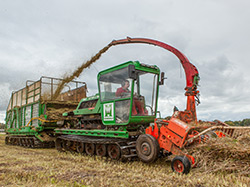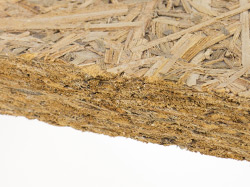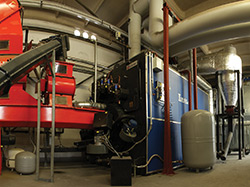Paludiculture on fen sites
Paludiculture on fens is a site-specific alternative to the use of drained fen sites. For cultivated crops, a targeted establishment of new stands is necessary. This changes the landscape and habitat value. Wet meadows, on the other hand, form on grassland sites by themselves through spontaneous succession after water levels have risen.
Adapted management of wet areas

Wet moorland sites place special demands on management, especially with regard to accessibility. Soil-friendly use is only possible with adapted technology, i.e. with low pressure on soil, suitable harvesting methods, and special consideration for logistics (e.g. avoiding driving on the same section multiple times). In addition to various small-scale techniques, the following harvesting techniques are available for wet bog sites:
Adapted conventional agricultural technology
Tractors with terra or twin tires, bogie belts, or delta tracks, with light mower attachment and light baler can be used in moderately wet areas or during the brief drop in water levels during summer. Adapted conventional farm equipment is limited by water levels and weather but preforms well.
Chain-based special technology
Special machines with chains and converted snowcats can be used on very wet areas. The large contact surface on these machines enables low ground pressure even with relatively heavy machines. The disadvantage is that the machines are not approved for road travel. In addition, these conversions are usually one-off solutions and require a great deal of technical know-how on the part of the users.
Balloon tire technology
Seiga machines with balloon tires are used for reed harvesting. The lightweight machines can travel even on very wet sites. However, production has been discontinued and only old machines or replicas are in use.
Utilization of biomass from wet fens

Material utilization
"Material utilization" refers to the refinement of fen biomass into construction and insulation materials or new products for the bioeconomy. Reeds and cattails can be refined into high-value building materials such as insulation materials, construction panels, or as traditional roofing reeds. The cultivation of black alder under wet (natural) conditions enables the production of valuable wood for furniture manufacturing.
Energy utilization
Energy production occurs through burning biomass to create CO2 neutral heat or by utilizing the biomass as a CO2 substrate in biogas plants. Reed harvested in winter has much better fuel properties than straw. However, sedge and reed canary grass hay from summer mowing can also be converted into heat in adapted combustion plants.
Average figures for fen biomass
Calorific value ( w 15%) 14.5GJ per t (=4 MWh)
Productivity 2-10 (5) t dry matter per hectare
Fuel oil equiv. ( w 15%) 200 l fuel oil per t dry matter
Forage utilization
Wet and moist lowland peatland grassland can be used for forage production, either for hay production or grazing. Water buffalo are already used in many places in landscape management for grazing wet sites and can also utilize lower-energy plant stands unlike traditional cattle. In addition to the landscape management water buffalo provide, they can provide meat, leather, and dairy products.

Since June 2014, Malchin has been supplying 540 households, a kindergarten, and a school with 4000 MWh of heat per year (equivalent to 350,000 L of oil) from a biomass heating plant with an 800 kW boiler. As fuel, 1000 t of reed canary grass and sedge hay from landscape management are used, which are harvested from about 200 ha of rewetted fens in summer.
The connection between sustainable heat supply, regional value creation and cultural landscape protection is promising. The Malchin heating plant project was awarded the German Local Sustainability Prize. more...
Improving the framework conditions
The implementation of further paludiculture projects requires an improved framework (e.g. direct payments, investment support). Cultivation of reeds and bulrushes should be recognized as agricultural use. Furthermore, it is recommended to reward the ecological services rendered (reduction of greenhouse gas emissions, creation of replacement habitats, flood protection, etc.).
Details
Sources & further Information
- Flyer "Landwirtschaft auf nassen Niedermooren"
- Wichtmann, W., Schröder, C. & Joosten, H. (Hrsg.) 2016: Paludikultur – Bewirtschaftung nasser Moore. Schweizerbart, Stuttgart, 272 Seiten
- Crops and livestock.











